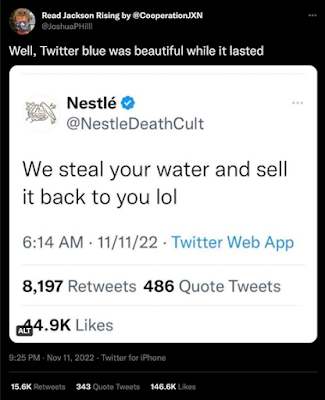Twitter Blue Fiasco – “Please note that Twitter will do lots of dumb things in coming months”, tweeted Elon Musk
What’s up with Nintendo tweeting a picture of Mario pointing a middle finger right at me? Oh wait… this is a fake Nintendo Twitter account. Why then is there a check mark next to it saying it’s “verified"?
Following Elon Musk’s $44 billion acquisition of Twitter, throughout this month, we (and the world at large) have all been following with some confusion what’s happening to and at Twitter. Amongst all of the issues, the one that drew the most attention would definitely be the launch of the $8-a-month verification service in selected countries such as the US, the UK, Canada, and Australia.
In short, Twitter’s new verification (commonly referred to as “Twitter Blue”) is a pay-to-play verification scheme. This Kat would have thought this would not cause such big of a spur as verification of this sort have all been present on Twitter as well as other social media platforms such as Instagram and Weibo. This Kat is wrong. Despite Twitter Blue being a verification scheme, it seems that Twitter is not checking the actual account holder’s identity. As soon as the fee is paid, a verification in the form of a blue tick will be given (as a matter of several minutes in the experience of Geoffrey A Fowler of the Washington Post). This has led to an explosion of fake accounts claiming to be famous celebrities, politicians, and brand owners. Even Elton Musk’s own company Tesla was not off the hook:-
While the above posts could be considered to be more on the satirical side, there are instances where Twitter Blue has caused damage to brand owners such as Eli Lilly and Lockheed Martin Corp, with significant drop in stock value after posts from fake Twitter Blue verified accounts:-
It is obvious that, by posing as the brand owner and posing fake news in its name, the fake account holders could commit acts of, inter alia, trade mark infringement and passing off/unfair competition. However, going after these individual fraudsters could raise concerns due to a number of reasons. First, it is challenging to identify the true individuals operating these accounts. Second, even if these individuals were identifiable, they would unlikely have the resources to compensate for the damages caused. Thus, such claims would only be successful “on paper”.
The alternative option would therefore be to act against the online platform operator itself, asking a court to hold the platform liable for enabling and assisting the wrongdoings. The liabilities of the online platform operator would be “secondary” in nature as they are dependent on the existence of the “primary” liability of the fraudsters. There are considerable difficulties in this line of argument though. In the UK, for instance, it would be necessary to satisfy a court that the online platform operator is a “joint tortfeasor”. In particular, there must be “procurement”. As suggested in case law such as Amstrad CBS Songs v Amstrad [1998] 1 AC 1013, procurement, whether by inducement, incitement or persuasion, “must be by a defendant to an individual infringer and must identifiably procure a particular infringement in order to make the defendant liable as a joint infringer”. In normal circumstances, it would be difficult to prove that an online platform operator encouraged users to commit fraudulent acts. There is simply no reason for a platform operator to do so.
Further, there are certain defences which online platform operators can rely on. A common one is the absence of knowledge of the wrongdoing, as demonstrated in the case of L’Oréal SA v eBay International AG, where the High Court stated that eBay “did not know that such infringements had occurred and were likely to continue to occur” and this (amongst other factors) were not enough to make eBay liable as joint tortfeasors. A court would also consider the platform’s takedown policy (if any) when considering liability, and the likely situation is that the platform would have taken down the fraudulent accounts or posts prior to commencement of action.
Of course, as the saying goes, every situation must be considered on a case-by-case basis. In this Twitter Blue situation, perhaps there is now a complete break-down of Twitter’s detection system? There is news that full-length movies can now be posted on the platform (see here). One would also question the effectiveness of Twitter’s complaint and takedown system when so many top legal executives are now “gone” (see here).
Meanwhile, we shall wait and see how Twitter is working on “keep what works & change what doesn’t” as Elon Musk tweeted.
 |
(This Kat is busy sweeping the house.) |
(Images taken from Marketing-Interactive (here), AIM (here), and Yahoo Finance (here))
Twitter Blue Fiasco – “Please note that Twitter will do lots of dumb things in coming months”, tweeted Elon Musk
 Reviewed by James Kwong
on
Monday, November 28, 2022
Rating:
Reviewed by James Kwong
on
Monday, November 28, 2022
Rating:
 Reviewed by James Kwong
on
Monday, November 28, 2022
Rating:
Reviewed by James Kwong
on
Monday, November 28, 2022
Rating:










![[GuestPost] G1/24: Tuning in! A take on the state of proceedings before oral proceedings](https://blogger.googleusercontent.com/img/b/R29vZ2xl/AVvXsEjZhEivE5bp7QOwZsyZXAXbVNYSmLjUthkB2Q7fm1_dpB97u5lIQeyWT9ZadUTAH3Z-hXn13VpW4vBDRPx9emCnoDV6tbUTkyvfmqPv1nNInL8XMdrAtSZ2hcRQr2LjxKovC9wTk_XyZxQ0CtX1MUrO_Muz3OJ4ld8AftymsdUmKD7xNksYMwk6/s150/Picture%201.png)

![[Guest post] ‘Ghiblification’ and the Moral Wrongs of U.S. Copyright Law](https://blogger.googleusercontent.com/img/b/R29vZ2xl/AVvXsEhxl1BQBAW3Y-asjb1xXB9eA4DYy77fky6WgR-prC-_6DeBbDqOgCUDWyiz0Q3B23MWWAXnkbS2H2js7OUwA0JQXAHmsyVFgGIHeJz7zJ791vTzOD-4SJqWFIuywFXQyd3ahybbdZd4e8IEVfcNqctvyR8lumv_Gix6Tsw5cSvbHpTI1nwvztDuAQ/s150/IMG_2179.HEIC)


![[Guest book review] The Handbook of Fashion Law (with a discount code)](https://blogger.googleusercontent.com/img/b/R29vZ2xl/AVvXsEgB4h2AdqJKwq9O3Ft4Mb7C39tv_NeFpkzrOfvhIsuwAkM_ops2Hgj7fdwzq_TQsjQDvQrQa-yyC9Q9pNiugseXRlUaMdsr_cmYUbh9lH8HDECMCbsTuNboVgpafyEhkgDkVS6ruHkuz8Sx0QVGI_1S8R9kbsHdNIYrRjqhyphenhyphen010_txjJUYvlZOtWA/s150/Fashion%20Law%20Book%20Bicture.jpg)






No comments:
All comments must be moderated by a member of the IPKat team before they appear on the blog. Comments will not be allowed if the contravene the IPKat policy that readers' comments should not be obscene or defamatory; they should not consist of ad hominem attacks on members of the blog team or other comment-posters and they should make a constructive contribution to the discussion of the post on which they purport to comment.
It is also the IPKat policy that comments should not be made completely anonymously, and users should use a consistent name or pseudonym (which should not itself be defamatory or obscene, or that of another real person), either in the "identity" field, or at the beginning of the comment. Current practice is to, however, allow a limited number of comments that contravene this policy, provided that the comment has a high degree of relevance and the comment chain does not become too difficult to follow.
Learn more here: http://ipkitten.blogspot.com/p/want-to-complain.html